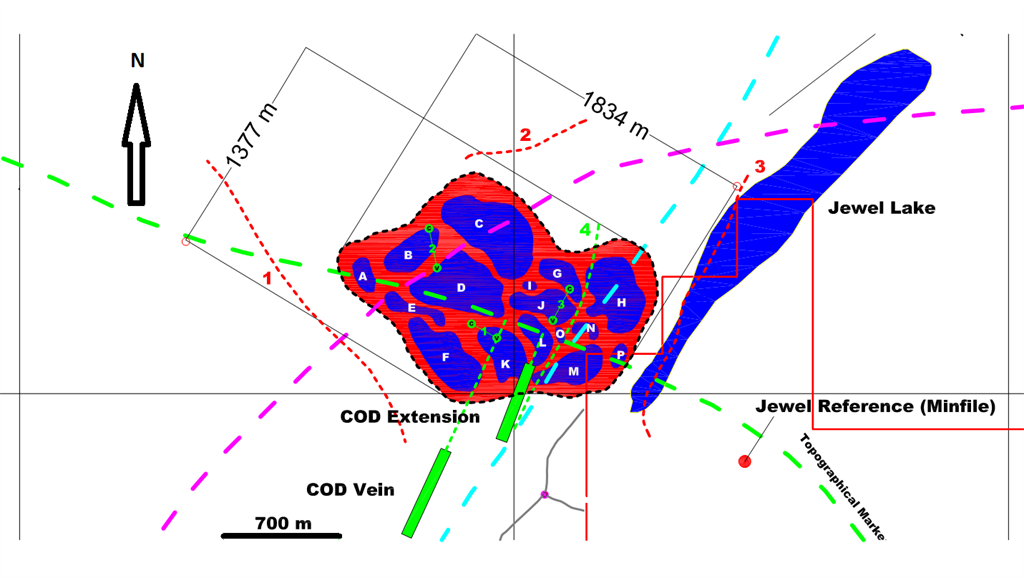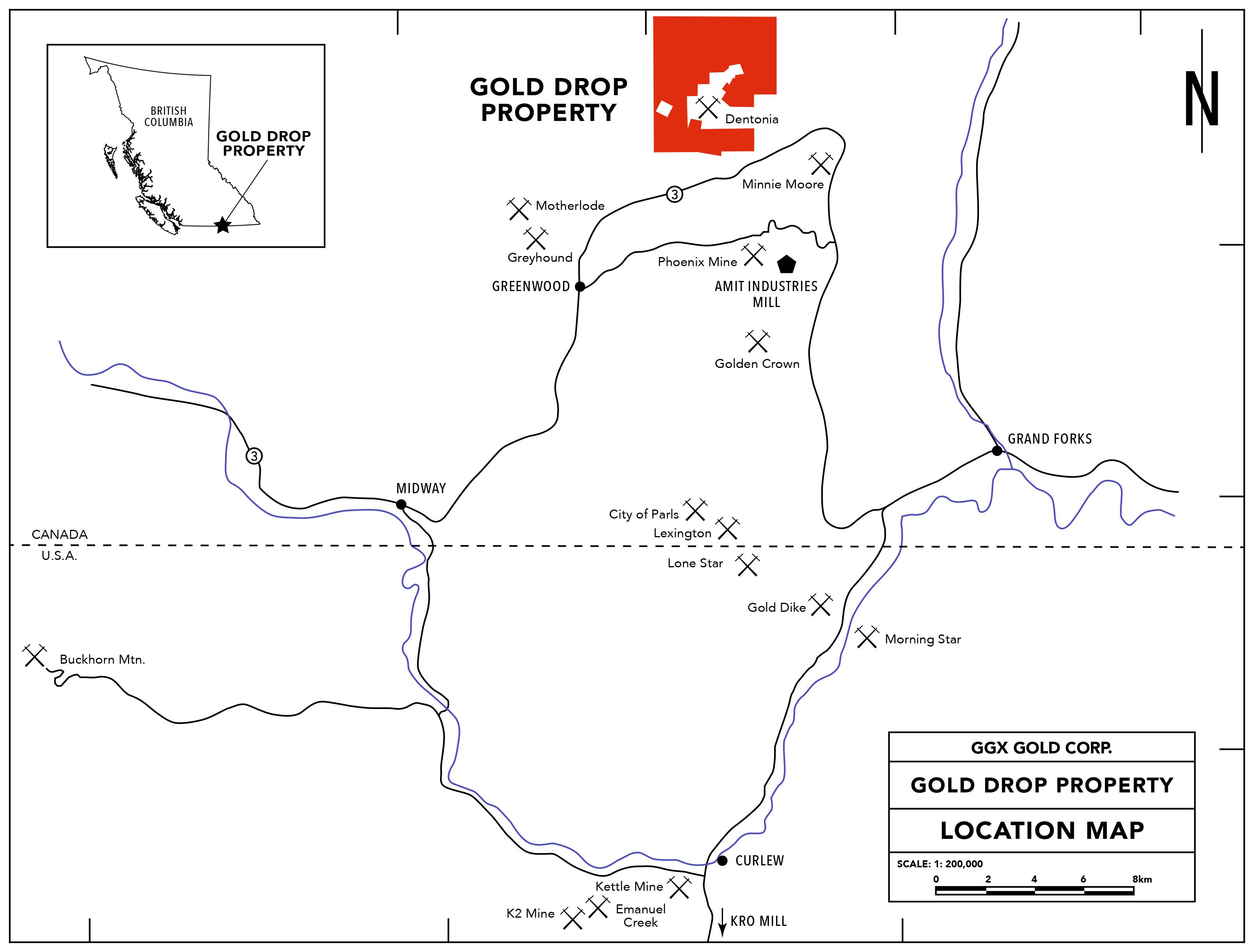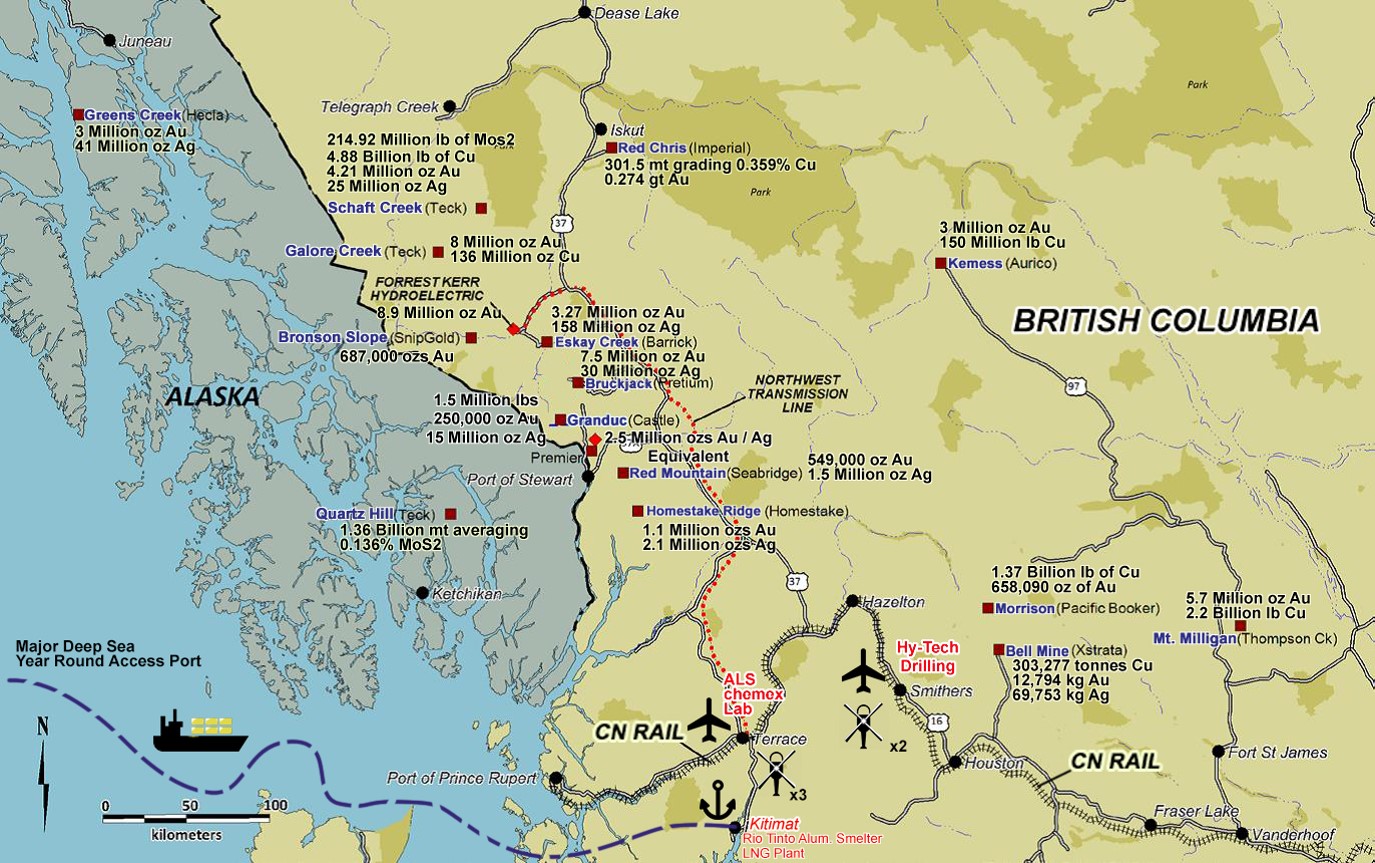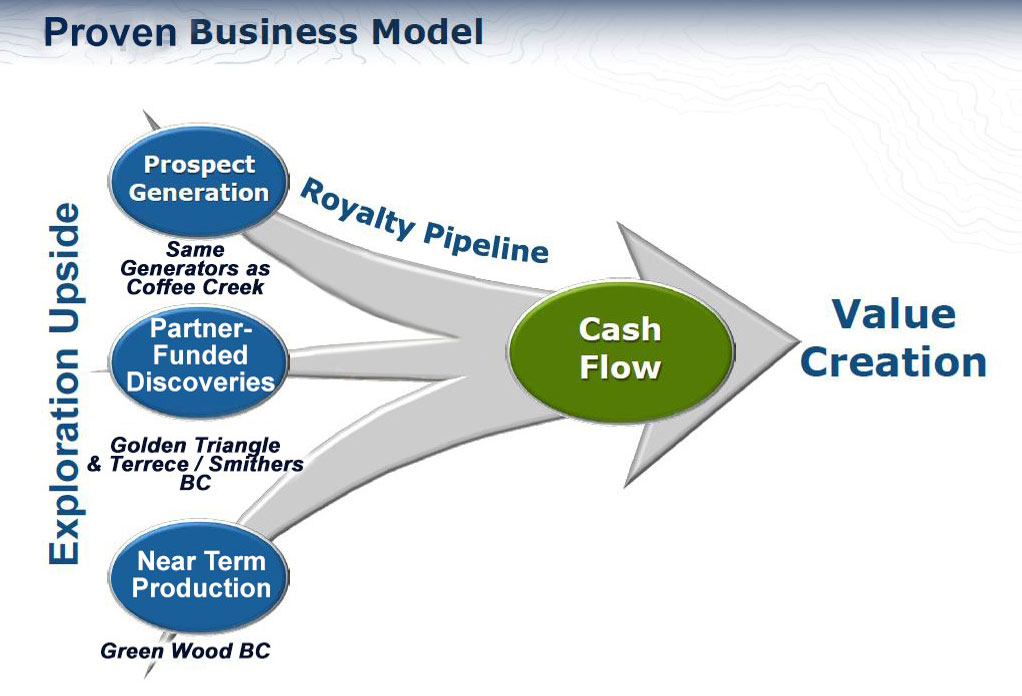
GOLD DROP PROPERTY WITHIN MULTIMILLION OUNCE GOLD PRODUCTION REGION
High Grade Gold Project in BC's Golden Triangle


Gold Drop Developments
- 2019 diamond drilling program currently under way.
- Announced that it is planning to drill a high priority geophysical target at its Gold Drop property in the Greenwood Mining Camp through proprietary Stargate II (SG II) Drill Target Modeling System
- It incorporates Acoustic EM analysis, technology that was developed by Earth Science Services Corporation of Oshawa, Ontario (ESSCO). SG II employs an enhanced, deep-penetrating ultra-sonic AMT (Audio-Magnetotellurics) geophysical survey.

The 2018 exploration program returned encouraging results including:
- The most significant gold drill intersections (core length) from the phase 3 diamond drilling on the COD vein are as follows:
- COD18-3: 14.62 g/t Au over 2.1 metres;
- COD18-26: 10.30 g/t Au over 1.4 metres recovered core (within 2.35-metre interval);
- COD18-28: 11.30 g/t Au over 0.51 metre;
- COD18-33: 8.65 g/t Au over 2.98 metres;
- COD18-34: 6.16 g/t Au over 3.41 metres;
- COD18-37: 8.23 g/t Au over 3.95 metres;
- COD18-45: 50.10 g/t Au over 2.05 metres;
- COD18-46: 54.90 g/t Au over 1.47 metres;
- COD18-49: 9.52 g/t Au over 1.47 metres;
- COD18-54: 7.60 g/t Au over 1.66 metres.
- The 2018 drilling program also tested the continuation of the Everest vein, which is located southwest of the COD vein work site. Chip samples collected in 2017 across the approximate 0.4-metre-wide vein exposure returned up to 52.8 g/t gold and 377 g/t silver, while a grab sample of a quartz vein boulder broken off the outcrop by the excavator returned 81.8 g/t gold and 630 g/t silver (news release of Aug. 21, 2017).
- The Everest vein 2018 drill holes are located approximately 350 to 800 metres south of the area of 2017 and 2018 COD vein drill holes. High gold intersections (core length) from the phase 3 drill program at the Everest vein include (news release of July 19, 2018, and Sept. 13, 2018):
- EVE18-5: 10.55 g/t Au over 0.45 metre;
- EVE18-12: 12.45 g/t Au over 0.85 metre.
PROPERTIES

GGX Gold’s most developed project is the Gold Drop property in Greenwood, BC, which was mined intermittently from 1919 to the 1980s with most production prior to 1942.
- Historical production totals 7572 tonnes at an average grade of 5.2 g/t Au and 93.4 g/t Ag. The 7572 tonnes was mined from three main veins (Amandy, North Star and Gold Drop). There was also limited mining at the Roderick Dhu vein in 1940 (25 tonnes mined at 19.9 g/t Au and 275 g/t Ag)
- Historical expenditure of approx $10m (current dollar terms) spent on Gold Drop, and $1 million spent recently by XIM.
- In addition to drilling this summer, GGX will be establishing small scale production using hopper/feeder module which can run four tonnes per hour.

Historic shaft in southwest region
- Material from Gold Drop’s property returned over 90% recovery:
Download the 2016 Gold Drop 43-101
Land Package: Comprised of 9 crown grants and 11 mineral claims that together cover an area of approximately 2150 hectares.
Location: The Gold Drop property is centered about 9 kilometres northeast of Greenwood, in Southern British Columbia.
Permitted: Notice-of-work permit from the Ministry of Energy and Mines for phase 1 exploration work on the Gold Drop property has been granted. The approved work permit is a multiyear permit, valid until Dec. 1, 2018, that enables the company to establish up to 20 drill sites and up to 25 excavator trenches on the property. The primary purpose of the work permit is to allow the company to identify areas for bulk sampling.
Infrastructure: Power is available on the property. Water is available, seasonally, from a small pond or several small creeks on the property, or from Jewel Lake. Services, including room, board and fuel, are available in Greenwood (population < 700).
Access: There is road access to the property from Greenwood, by Highway 3 for 4 km to the Boundary Creek road, for 1.5 km and a further 9 km on the Jewel Lake road to the Jewel Lake-Eholt road. .

Pyrite bearing quartz float in southwest region of Gold Drop Property
Bulk Sampling: Historical production totals 7572 tonnes at an average grade of 5.2 g/t Au and 93.4 g/t Ag from three main veins (Amandy, North Star and Gold Drop). The average mined grade is significantly affected by a large volume of very low grade material that was removed from the North Star mine in 1934-35. Omitting production from these years, the average grade for the remaining 2505 tonnes mined from the property is 13.1 g/t Au and 133.7 g/t Ag. There was also limited mining at the Roderick Dhu vein in 1940 (25 tonnes mined at 19.9 g/t Au and 275 g/t Ag).
GGX 2017 Work: The 2017 program commenced with a thorough prospecting program of recent clear cuts on the property. The prospecting located the historical COD mineshaft and several new vein exposures. Following the receipt of prospecting assays, including 19.65 g/t gold from the COD vein outcrop, the company immediately moved into a trenching and channel sampling program of the COD vein. The trench exposed the vein for approximately 160m with samples collected at 1.5m intervals. The channel samples returned numerous high grade intercepts including 43.2 gpt gold and 224 gpt silver. Drilling followed to delineate the vein body at depth and strike along the trench. The drill program yielded promising results with the highlight being hole COD17-14 that graded 4.59 g/t Gold and 38.64 g/t Silver over 16.03 meters core length with a high grade core grading 10.96 g/t Gold and 89.86 g/t Silver over 5.97 meters core length. During fire season the company carried out a thorough prospecting and soil sampling program in the COD north and near the new found Everest vein. The Everest vein was discovered by hand pitting on local quartz float. It has since seen 60m of trenching and chip sampling. The highlights from the chip sampling include 81.8 gpt gold and 630 gpt Ag. The soil sampling program helped locate further anomalies, and trenching targets north of the COD work site.
Land Package: Comprised of 9 crown grants and 11 mineral claims for an approximate 2150 hectares.
Location: The Gold Drop property is centered about 9 kilometres northeast of Greenwood, in Southern British Columbia.
Permitted: Notice-of-work permits from the Ministry of Energy and Mines for drilling and trenching work on the Gold Drop property are in place.
Description: Description: The property covers geologically prospective ground in the well-mineralized Greenwood District, and hosts 8 or more known low-sulfide, gold-bearing veins or vein systems, including the North Star (082ESE152), Gold Drop (082ESE153), Amandy (082ESE126), Lakeview (082ESE056) and Moonlight (082ESE224).
Infrastructure: Power is available on the property. Water is available, seasonally, from a small pond or several small creeks on the property, or from Jewel Lake. Services, including room, board and fuel, are available in Greenwood (population < 600). Grand Forks, with a population of about 8,000 in the city and immediate surrounding area, is a major supply center. Most services needed for exploration are available in Grand Forks, located 40 km east along Highway 3 from Greenwood. The closest full-service airports are located in Kelowna, Penticton or Castlegar.
Access: There is road access to the property from Greenwood, by Highway 3 for 4 km to the Boundary Creek road, for 1.5 km and a further 9 km on the Jewel Lake road to the Jewel Lake-Eholt road. Access to the eastern part of the property can be obtained through the Dentonia mine site. Several spur roads provide 4-wheel drive access to other parts of the property.
The terrain is moderate to locally steep, with elevations ranging from 1135 metres along the shores of Jewel Lake, to 1612 metres at the summit of Mt. Pelly and 1800 metres near the summit of Roderick Dhu. Outcrop on the property is variable, typically averaging less than 10%. Rock exposure is better in steeper portions of the property but is scarce in the more gently sloping areas. The scarcity of outcrop in these low sloping areas hampers prospecting and mapping efforts. Vegetation consists of relatively open second growth fir and larch forest, with little undergrowth. Portions of the property have recently been logged. The climate is moderately dry, with hot summers and little rainfall. Snowfall is in the order of 2-3 metres and the property is generally snow free from early May to late October. Water is available, seasonally, from small ponds or several small creeks on the property, or from Jewel Lake.
Climate: The climate is moderately dry, with hot summers and little rainfall. Snowfall is in the order of 2-3 metres and the property is generally snow free from early May to late October.
Geology & Mineralization: Metamorphic rocks of the Paleozoic Knob Hill Complex underlie the claims. These rocks have been intruded by granodiorite and diorite of the Jurassic-Cretaceous Nelson Plutonic suite and by biotite syenite and diorite/andesite dykes of the Eocene Coryell suite. Gold-bearing veins in the area post-date the Nelson intrusives and pre-date the Coryell suite. The area is complexly faulted, including north-trending, steeply dipping strike-slip and normal faults, and low-angle detachment-type faults, both which post-date mineralization.
The deposit style, tabular (high-grade) veins tend to occur in more competent host rocks. Veinlets, stringers and stockworks form in less competent lithologies and within broad fracture zones and can result in lower grade bulk-mineable deposits. Potential also exists on the claims for low-grade, bulk-tonnage gold mineralization related to broad fracture or stockwork zones. GGX Gold has acquired the property on the basis of both its exploration and mining potential.
Processing: The property is in proximity to several mills including the Kinross Kettle River Buckhorn mill which is currently operating at half capacity.
Bulk Sampling: Historical production totals 7572 tonnes at an average grade of 5.2 g/t Au and 93.4 g/t Ag from three main veins (Amandy, North Star and Gold Drop). The average mined grade is significantly affected by a large volume of very low grade material that was removed from the North Star mine in 1934-35. Omitting production from these years, the average grade for the remaining 2505 tonnes mined from the property is 13.1 g/t Au and 133.7 g/t Ag. There was also limited mining at the Roderick Dhu vein in 1940 (25 tonnes mined at 19.9 g/t Au and 275 g/t Ag).
History: Historic work on the property can be divided into 3 periods, an early period of activity in the late 1890’s and early 1900’s when most of the veins were discovered, a period of work in the 1930’s and 1940’s when most of the underground development work was done and when most of the historical production was achieved, and a more recent phase from 1980 through to the present when limited surface and underground exploration work was done. Most of the historic work was geared towards finding ore zones along the veins that could be mined. Only very minor trenching and drilling has been done, and systematic property-wide exploration work is lacking.
Path Forward: The 2018 drill program will aim to further delineate the quartz vein at depth and strike. Several exploration holes are planned in the COD north and the high grade Everest vein areas. Further details TBA.

Private Syndicate and the Golden Triangle
The Golden Triangle district has become one of the most important metal regions in Western Canada and is being further enhanced with recent significantly improved infrastructure, including paving of the Stewart-Cassiar highway north from Smithers, ocean port facilities for export of concentrate at Stewart, and completion of BC Hydro’s 287 kilovolt Northwest Transmission Line from Terrace to Bob Quinn Lake and north to the Red Chris mine.
Prior to the recently funded program below, the private syndicate in question had already invested over 3 years and 1000 man-hours compiling data to generate proprietary Gold & Silver targets for the partnership in the Golden Triangle. GGX currently owns 9% of any property or NSR that comes out of this Syndicate.
12 MONTH STOCK CHART



